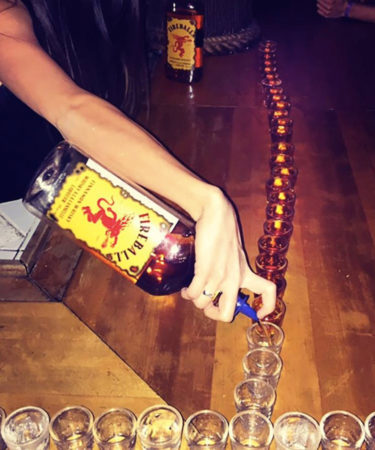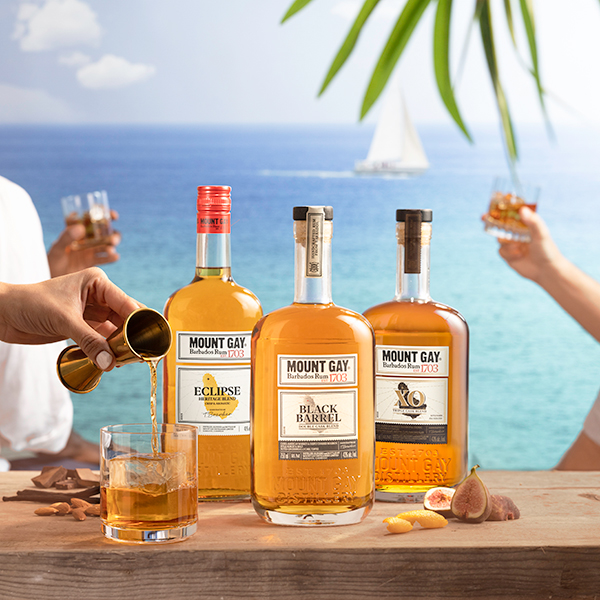If you’re drinking like the rest of the country, most of what you learn about Fireball is forgotten by morning. And that’s fair. It isn’t really a drink made for thoughtful fireside sipping.
But given the meteoric rise of Fireball Cinnamon Whisky, which has grown from $1.9 million in sales in 2011 to $863.5 million in 2014, it’s hard not to be a little curious about the stuff — what dragon’s lair it came from, say, or why people love it so much.
In honor of the shot that keeps on giving, whether we want it to or not, here are 10 things you should know about Fireball.
It’s not technically “whiskey.”
Whiskey is defined as a spirit “bottled at not less than 40% alcohol by volume (80 proof).” Clocking in at a lower 33 percent ABV, or 66 proof, Fireball is more of a flavored whiskey, or, to be super technical, a “specialty” distilled spirit — albeit one trying to up its bad-ass quotient with the name Fireball and a sick dragon logo.
We might have to thank — gasp — Canada for Fireball.
Insofar as “Fireball” mythology exists, at least one origin story points to a Canadian bartender trying to warm up on one of those classically unforgiving-yet-sexy Canadian nights. Apparently booze alone wouldn’t suffice (it also doesn’t really warm you up), so our mystery bartender added cinnamon and sugar. Like if you were making toast, but to get drunk with. There’s also a solid chance the stuff was invented when someone dropped some Mike and Ike Hot Tamales into moonshine and just went for it.
Fearmongering time! Fireball was recalled due to concerns it contained an ingredient used in anti-freeze.
Otherwise known as propylene glycol, otherwise known as part of the mixture used to de-ice airplanes. In 2014 Fireball was recalled in European countries because propylene glycol levels were deemed too high for those markets. But don’t worry, party animals, both the FDA and CDC have deemed propylene glycol safe at low levels of consumption (per the FDA, “about 50 grams per kilogram” in food). Fireball replaced its European bottles immediately and has not recalled any products in the U.S. Also, you’ve probably been consuming propylene glycol for a while now; it’s used in everything from cosmetics to e-cigs to, God help us, delicious ice cream.
People cook with it. On purpose.
Anti-freeze or no, people are still happily incorporating Fireball into a wide, weird variety of recipes ranging from marshmallows to meatballs. Of course there are the trillion different Fireball shots recipes, but the food is where it gets really interesting. Our personal favorite might be the company’s own “Firebagel” recipe, which definitely wins points for ease of execution and also being totally unnecessary.
Chris Pratt once got drunk on it and gave acting lessons.
It’s unclear whether this video of dinosaur-whisperer Chris Pratt was blatant product placement, the result of a genuine love of Fireball, or both, but it’s a video worth watching. At the end of an interview with GQ, Pratt is asked to give some free acting lessons, which he does, while blitzed on Fireball. (Adult language is used.) His best advice comes at the end — either when Pratt recommends how to convince your spouse you didn’t miss their birthday or how to really make it in Hollywood. One thing is clear: It’s all wisdom fueled by the ‘Ball.
Fireball was a late bloomer.
Fireball is like the girl in the movie who wears glasses, takes off glasses, quits marching band, gets a makeover from a sassy friend, and begins a whirlwind romance with the Prom King, which in real life would likely lead to unplanned pregnancy and a bitter divorce. Fireball’s been around since 1984, but America only fell in love with it in the late 2000s. Part of the delay in popularity might have to do with the fact that it was stuck in Canada until 2001 with the less-than-sexy name “Dr. McGillicudy’s Fireball Whisky.” But Sazerac bought it, gave it aforementioned makeover montage, and — most impressively — took to the streets to market the stuff face-to-face. Maybe the brand ambassadors all had dreamy eyes; either way, America fell head over heels.
There was a brief, ill-fated attempt at boxing Fireball.
Not every Fireball branding experiment worked. Take all the classiness of Fireball and add all the classiness of box wine and you have the failed 2016 experiment known as the “Firebox,” which, again, somehow didn’t succeed, despite being so damn classy.
You too can have Fireball swag.
Two successful aspects of Sazerac’s Fireball makeover: rebranding with that edgy dragon logo, and hyping it via aggressive merchandising (hot sauce, thongs, T-shirts with slogans that appear to be some kind of half-assed legal defense.) The dragon features heavily in Fireball swag, but there’s also dragon-specific slang. For instance, drinking Fireball is called “slayin’,” as in, “Cancel your plans for tomorrow, Derek, ‘cause we’re slayin’ tonight.”
Fireball went to Coachella and you didn’t.
Another massive component of the brand’s resurgence is its embrace of social media, with almost 80K-strong Instagram followers and hashtag campaigns like #FireballAroundtheWorld, where Fiery ‘Ballers (how can this not be their nickname?) photograph themselves with Fireball everywhere from Nicaraguan hot tubs to (poorly planned?) snowy mountain excursions. Fireball even scored tickets to Coachella. Traditionally, of course, the majority of us are drinking Fireball out of a Solo cup in our broheme’s crowded kitchen or, if it’s been a really long week, just knockin’ it back in the tub.
There’s an app for that.
More accurately, there’s an app for the official Fireball drinking game, “Dragons, Dice & Dares.” Unfortunately there are very few dragon-related challenges in the game. Instead you’ll see your classic disrobing challenges, forced confession of embarrassing personal history, and, of course, toilet paper-related dares. Tastes like heaven. Burns like hell. Convinces you to put toilet paper on your head.

